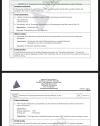This is the correct answer.
You can get further supporting information about degradation due to high temperature by reading section
2.7 DTA/TG Analysis
of
Testosterone (17β-Hydroxyandrost-4-en-3-one) is the primary male anabolic-androgenic steroid. The crystal structures of two medium and two long esterified forms of testosterone, including enanthate, cypionate, decanoate and undecanoate, were ...

pmc.ncbi.nlm.nih.gov
DTA/TG curves of analyzed compounds are shown in Figure S5 (Supporting Information). Small endothermic peaks appear at (42 °C for Tena), (97 °C for TCyp), (49 °C for TDec) and (65 °C for TUnd), and are assigned to the melting points of the compounds. It should be mentioned that TEna has the lowest melting point, and in the solubility evolution process it became gelatinous even though it was assessed at 14 °C.
With the increase in temperature, no thermal events occurred until the onset temperature of 320 °C for long esters (TDec, TUnd) and up to 350 °C for medium esters (TEna, TCyp).
Further, two broad exothermic peaks were recorded. The first peak had its maximum at the following temperatures: (381 °C, TEna), (393 °C, TCyp), (378 °C, TDec) and (387 °C, TUnd). This peak can be attributed to the process of degradation and oxidation of organic matter, accompanied by a significant loss of mass. The second exothermic peak, with maxima (544 °C, TEna), (537 °C, TCyp), (540 °C, TDec), (540 °C, TUnd), can be associated with the decomposition and oxidation of the remaining material simultaneously with a less significant loss of mass. Similar thermal behavior has been reported for other active pharmaceutical ingredients such as riboflavin and norfloxacin
This study has also been used here for reference purposes regarding testosterone solubility for different esters in different carrier oils. Unfortunately, a slight mathematical modification of the solubility results must be made to show the information using the same context we do about mg/ml in our normal discussions. If the results are not recalculated, we will mistakenly believe testosterone mg/ml limits are significantly higher than what we are used to, which is not the case.
I am curious if anyone else has found our misinterpretation "mistake."



